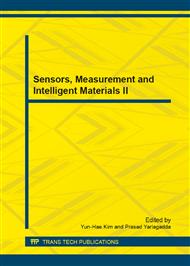[1]
A. E. Buck, C. L. McDonald, S. H. Lewis and T. R. Viswanathan, A CMOS Bandgap Reference without Resistors, IEEE J. Solid-State Circuits, vol. 37, pp.81-83, Jan. (2002).
DOI: 10.1109/4.974548
Google Scholar
[2]
G. D. Vita and G. Iannaccone, A Sub-1-V, 10 ppm/°C, Nanopower Voltage Reference Generator, IEEE J. Solid-State Circuits, vol. 42, pp.1536-1542, Jul. (2007).
DOI: 10.1109/jssc.2007.899077
Google Scholar
[3]
A. Cabrini, G. D. Sandre, L. Gobbi, P. Malcovati, M. Pasotti, M. Poles, F. Rigoni and G. Torelli, A 1 V, 26 μW Extended Temperature Range Band-gap Reference in 130-nm CMOS Technology, Proceedings of the 31st European Solid-State Circuits Conference (ESSCIRC 2005), pp.503-506, Sep. (2005).
DOI: 10.1109/esscir.2005.1541670
Google Scholar
[4]
X. F. Gong, M. J. Liu, B. Zhou and J. X. Dong, A Novel Wide Temperature Range Bandgap Reference, 55th International Midwest Symposium on Circuits and Systems (MWSCAS 2012), pp.506-509, Aug. (2012).
DOI: 10.1109/mwscas.2012.6292068
Google Scholar
[5]
H. Y. Huang, R. J. Wang and S. C. Hsu, Piecewise Linear Curvature-Compensated CMOS Bandgap Reference, 15th IEEE International Conference on Electronics, Circuits and Systems (ICECS 2008), pp.308-311, Aug. (2008).
DOI: 10.1109/icecs.2008.4674852
Google Scholar
[6]
K. N. Leung and P. K. T. Mok, A CMOS Voltage Reference Based on Weighted ΔVGS for CMOS Low-Dropout Linear Regulators, IEEE J. Solid-State Circuits, vol. 38, pp.146-150, Jan. (2003).
DOI: 10.1109/jssc.2002.806265
Google Scholar
[7]
A. Boni, Op-Amps and Startup Circuits for CMOS Bandgap References With Near 1-V Supply, IEEE J. Solid-State Circuits, vol. 37, pp.1339-1343, Oct. (2002).
DOI: 10.1109/jssc.2002.803055
Google Scholar
[8]
D. Johns and K. Martin, Analog Integrated Circuit Design, Wiley, (1996).
Google Scholar
[9]
W. M. C. Sansen, Analog Design Essentials, Springer, (2006).
Google Scholar


